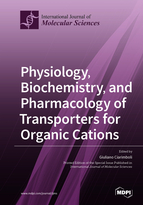Physiology, Biochemistry, and Pharmacology of Transporters for Organic Cations
A special issue of International Journal of Molecular Sciences (ISSN 1422-0067). This special issue belongs to the section "Biochemistry".
Deadline for manuscript submissions: closed (31 July 2020) | Viewed by 45018
Special Issue Editor
Interests: organic cation transporters; regulation; interaction with drugs; interaction partners
Special Issues, Collections and Topics in MDPI journals
Special Issue Information
Dear Colleagues,
The formation of a plasma membrane was an evolutionary important achievement to attain a controlled and protected cellular milieu. However, at the same time, the presence of a plasma membrane constituted a problem because it is impermeable to charged substances and impedes free exchange of molecules, such as nutrients and metabolites. The evolution of transport systems allowed overcoming this difficulty. This Special Issue of the International Journal of Molecular Sciences is dedicated to a special class of membrane transporters: the transporters for organic cations. Organic cations are endogenous and exogenous substances, which bear a positive charge at physiological pH. Important neurotransmitters, such as acetylcholine, dopamine, histamine, and serotonin, and metabolic products, such as creatinine, are substrates of these transporters. On the other hand, since many drugs and xenobiotics are of cationic nature, transporters for organic cations can have an important pharmacological and toxicological impact. Peculiar aspects of these transporters with important structure/function correlations are their polyspecificity, the presence of several polymorphisms, and a complex regulation. This Special Issue aims to collect the newest knowledge on physiological, biochemical, pharmacological, toxicological, and pharmacogenomic aspects of transporters for organic cations.
Prof. Dr. Giuliano Ciarimboli
Guest Editor
Manuscript Submission Information
Manuscripts should be submitted online at www.mdpi.com by registering and logging in to this website. Once you are registered, click here to go to the submission form. Manuscripts can be submitted until the deadline. All submissions that pass pre-check are peer-reviewed. Accepted papers will be published continuously in the journal (as soon as accepted) and will be listed together on the special issue website. Research articles, review articles as well as short communications are invited. For planned papers, a title and short abstract (about 100 words) can be sent to the Editorial Office for announcement on this website.
Submitted manuscripts should not have been published previously, nor be under consideration for publication elsewhere (except conference proceedings papers). All manuscripts are thoroughly refereed through a single-blind peer-review process. A guide for authors and other relevant information for submission of manuscripts is available on the Instructions for Authors page. International Journal of Molecular Sciences is an international peer-reviewed open access semimonthly journal published by MDPI.
Please visit the Instructions for Authors page before submitting a manuscript. There is an Article Processing Charge (APC) for publication in this open access journal. For details about the APC please see here. Submitted papers should be well formatted and use good English. Authors may use MDPI's English editing service prior to publication or during author revisions.







